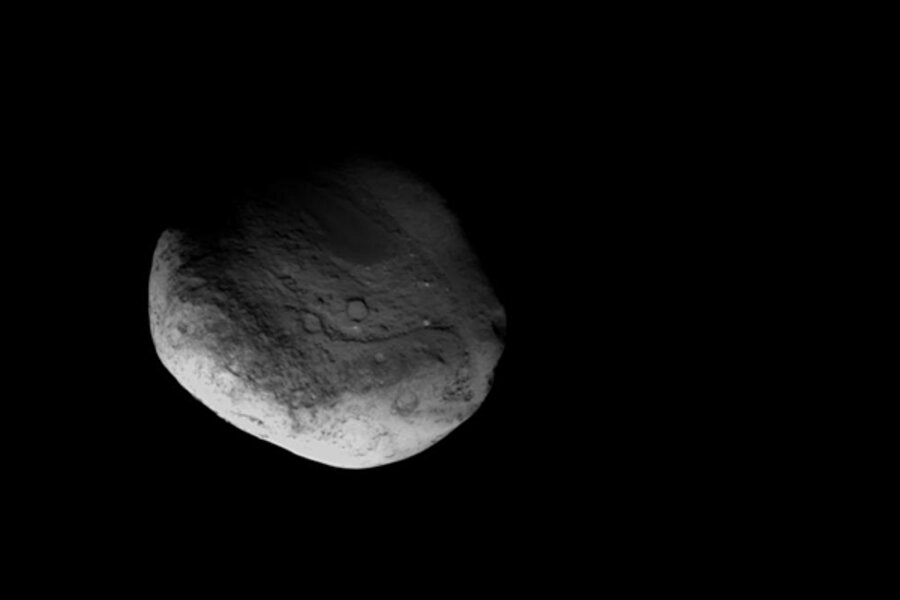Comet Tempel 1: Stardust photos reveal crater that 'partly healed itself'
Loading...
For the first time in history, humanity has gotten an up-close-and-personal look at a comet on successive swings around the sun, and the scientists involved couldn't be more elated.
The Stardust-NExT spacecraft sped past comet 9P/Tempel 1 at 11:39 p.m. Eastern Standard Time on Valentine's Day, and Tuesday afternoon, the science team unveiled images representing some of the flyby's greatest hits.
Among 72 pictures taken during closest approach to the comet's potato-shaped nucleus, the craft captured changes in the cometscape since it last was imaged by NASA's Deep Impact craft six years ago. The crater that mission's 800-pound projectile carved into the nucleus – obscured by dust during the Deep Impact flyby – also swung into Stardust-NExT's view. And the craft captured images of intriguing new regions of the nucleus's surface.
"If you ask me: Was this mission 100 percent successful in terms of the science? I would have to say: No," said an exuberant Joseph Veverka, a Cornell University solar-system scientist and the mission's lead researcher. "It was 1000 percent successful."
After a journey of 3.5 billion miles the craft passed 110 miles from the nucleus, colliding with dust particles in the comet's halo, or coma. The team converted the collision data into sound, yielding an audio track reminiscent of hailstones intermittently pummeling a tin roof.
During a briefing Tuesday afternoon, the team unveiled the photos of greatest interest – images taken during the flyby's closest approach to the comet.
Among the initial observations:
• In 2005, Deep Impact captured a sharply scarped plateau-like feature roughly two miles long and about 1,300 feet across. During this pass, the plateau showed significant signs of erosion – material lost during heating that liberated ices and gas during the comet's closest approach to the sun.
The plateau is likely a downhill flow of dust triggered by an outburst of gas at some point in the comet's past, Dr. Veverka says.
• The Deep Impact crater was barely discernible in the images the team released. But Brown University's Pete Schultz, a member of the Deep Impact and Stardust-NExT science teams, said the crater was readily apparent in stereo images as well as in new shots of the nucleus with in oblique sunlight.
The subdued crater is roughly 500 feet across and has a discernible mound in the middle, evidence Dr. Shultz says, that much of the ejecta the Deep Impact collision kicked up fell back onto the comet.
"The crater partly healed itself," he says.
• Views of never-seen-before features on portions of the comet Deep Impact didn't image "are simply amazing," Veverka says. The surface displays extensive layering, pits, and craters – clues he and his colleagues will sort through to uncover the geological history of Tempel 1 and the forces beyond solar heating that shaped it.
• A dust analyzer uncovered evidence for carbon and carbon bound with nitrogen – chemicals and chemical constructs that, in part, form the scaffolding for biologically important molecules, noted Donald Brownlee, another team member and a researcher at the University of Washington in Seattle.
The dusty coma surrounding the comet is "a very dramatic environment," he said, in which material is released from the nucleus "in bursts and puffs of clods and ice.
Stardust-NExT's initial objective when it launched in 1999 was to visit comet Wild 2 and return dust samples to Earth that the craft collected. The cost of the mission was on the order of $200 million.
But once it had dropped off its precious cargo – material that scientists are still studying – in 2006, the craft was in perfect health. At that point, Veverka proposed sending it back to visit Tempel 1 to follow up on Deep Impact's observations for an additional $29 million.
From all indications, the craft still is in great shape, notes Tim Larsen, the Stardust-NExT project manager at NASA's Jet Propulsion Laboratory in Pasadena., Calif. He says it will continue to take pictures of the comet for another week or two as the distance between the two grows.





